北京媒体艺术双年展:科学与技术如何生成艺术?
林佳斌
北京媒体艺术双年展:科学与技术如何生成艺术?
林佳斌
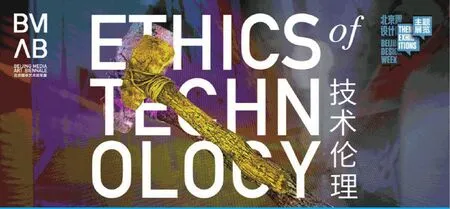
展览链接:
北京媒体艺术双年展
主 办:中央美术学院、北京国际设计周组委会办公室、德国B3动态影像双年展
展览时间:2016年9月24日—10月30日
展览地点:中华世纪坛艺术馆、中央美术学院美术馆
Exhibition Link:
Beijing Media Art Biennale
Sponsors: China Central Academy of Fine Arts, Beijing Design Week Organizing Committee, German B3 Biennale
Date: September 24—October 30, 2016
Venues: Art Museum of the China Millennium Monument, CAFA Art Museum
回望人类的文明历史,从农业时代、工业时代到当今信息爆炸的新语境下,科学技术的飞速发展虽然让我们心安理得地享受着生活的便捷,但与此同时,好莱坞电影里的各种人机大战、基因改写、生物变异、机器觉醒、虚拟现实等看似天马行空的情节已不再让人觉得新奇,甚至引发人类内心的稍许不安:在科学技术近乎失控的发展趋势下,如何建构一个防止技术滥用的伦理壁垒?
艺术作为文化、社会、技术等因素的混合产物,往往因那些具有敏锐嗅觉的天才艺术家的出现,而呈现出各
种文化浪潮的最前锋,因而新艺术的诞生创造了一种可能——以“跨学科、跨领域、高科技”的综合性为特征的媒体艺术当之无愧成为当下艺术界的时髦。此背景下,首届北京媒体艺术双年展应运而生,展览打出了“技术伦理”的主题,试图审视现有科技在实际应用中已经导致的伦理危机,并尝试探讨科技在未来可能产生的新的伦理问题。
北京媒体艺术双年展以双展馆的形式展开,分别是中央美术学院美术馆的“实验空间”特别展览与中华世纪坛艺术馆的“技术伦理”主题展。中央美术学院作为本届“北京媒体艺术双年展”的主办单位,与北京国际设计周组委会、德国B3动态影像双年展共同呈现展览。

盖里·希尔 墙 Gary Hill, Wall Piece
Looking back on the history of human civilization, from Agricultural Era, Industrial Era to the current new context of explosion of information, the rapid development of science and technology allows us to enjoy the convenience of life at ease on the one hand, and the seemingly arbitrary plots in Hollywood fi lms such as the war between man and machine, gene rewriting,biological variation, machine awakening and virtual reality no longer strike us as novel on the other. This undoubtedly implies a slight uneasiness in the human heart: How to construct an ethical barrier to prevent abuse of technology in the context of the nearly uncontrolled development of science and technology?
As a mixed product of culture, society, technology, etc.,art often tends to present itself as the vanguard in a variety of cultural waves as the result of the emergence of talented artists with a keen sense of s
mell, making the birth of new art possible. The media art characterized by the integration of“interdisciplinarity and high technology” is worthy of being described as fashionable in the world of contemporary art. In this context, the fi rst Beijing Media Art Biennale was held. With“Ethics of Technology” as its theme, the exhibition attempted to examine the ethical crisis caused by the practical application of existing science and technology, and to explore the new ethical problems that may be brought about by future science and technology.
Beijing Media Art Biennial consisted of two synchronous parts at two venues: the “Lab Space” special exhibition at Art Museum of China Central Academy of Fine Arts (CAFA Art Museum), and the “Ethics of Technology” thematic exhibition at Art Museum of China Millennium Monument. They were co-organized by China Central Academy of Fine Arts as the organizer of the “Beijing Media Art Biennale”, Beijing International Design Week Organizing Committee, and German B3 Biennial of the Moving Image.
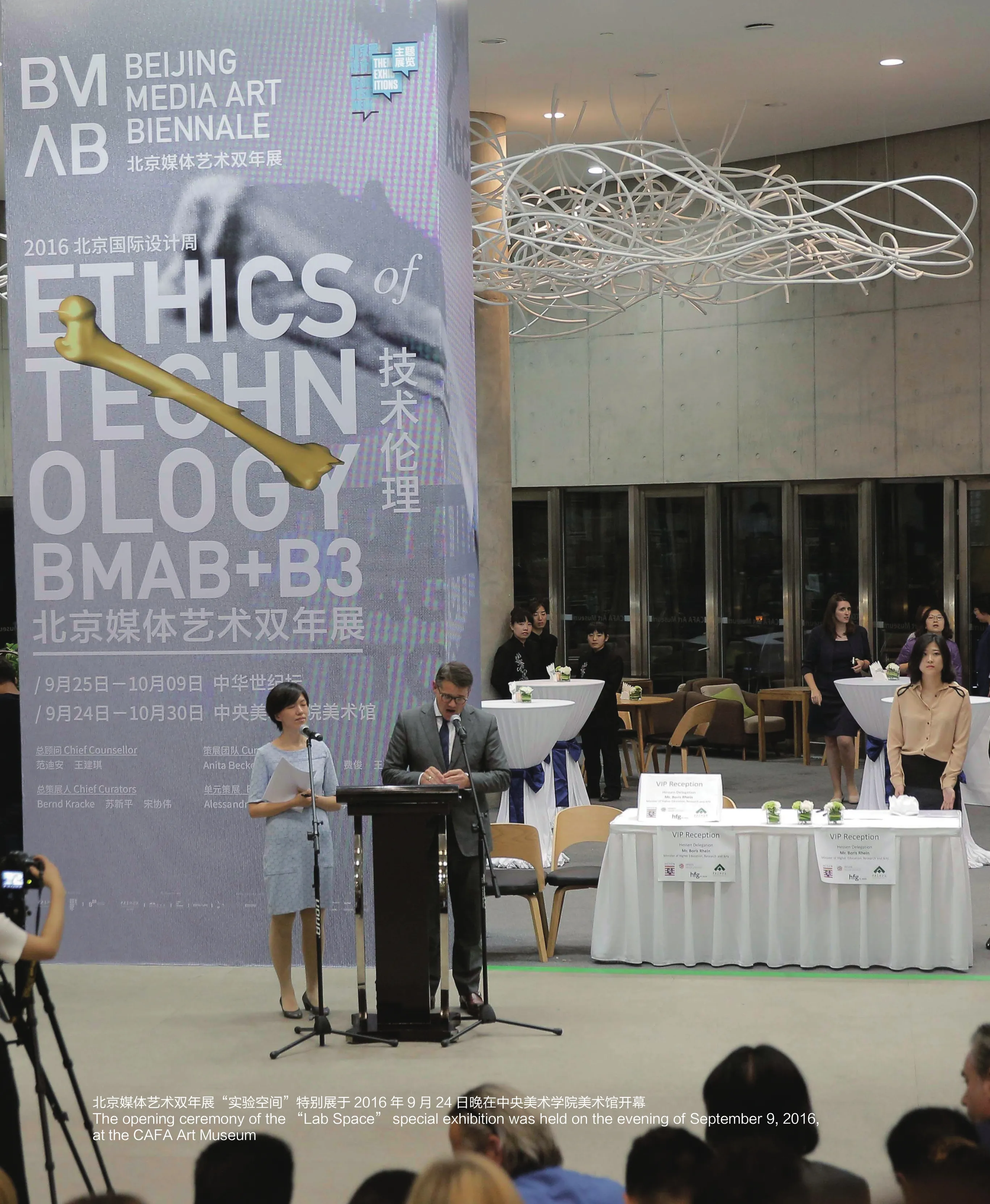
北京媒体艺术双年展“实验空间”特别展于2016年9月24日晚在中央美术学院美术馆开幕The opening ceremony of the “Lab Space” special exhibition was held on the evening of September 9, 2016, at the CAFA Art Museum
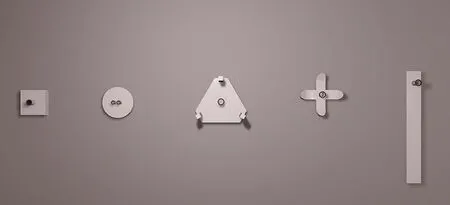
盖里·希尔 我Gary Hill, Self
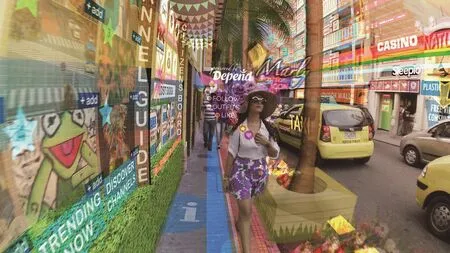
松田启一 超现实Keiichi Matsuda, Hyper-Reality
“实验空间”特别展览:以专题模式呈现
北京媒体艺术双年展“实验空间”特别展于2016年9月24日晚在中央美术学院美术馆开幕,此板块以专题的方式展示,包括盖里•希尔专题、VR专题、沉浸专题、电影专题、Experimenta专题、B3获奖艺术家专题,以及演出专题,这些专题分别以不同的艺术形式对“技术伦理”这一话题展开讨论。
在盖里•希尔专题中可看到艺术家盖里•希尔带来的7件作品,作品涉及影像、互动装置等。在短片《墙》中,可看到一个男人不断将自己摔往一面黑色背景的墙上,而突然出现的刺眼闪光灯捕捉住了每一撞击的瞬间;《大腿别哭》探讨不同物体之间干涉彼此边界的状态;在互动装置《我》里,当你被吸引着凑上那不同形状的窥视洞内时,看到的正是自己在“窥视”的画面……
值得一提的是,本次VR专题是迄今为止国内最大规模的对于VR作品的集中展示,在此专题中不仅有国内艺术家田晓磊、朗雪波与王跖、刘言韬、周戭等创作的VR作品,更有德国B3动态影像展推荐的VR电影与短片,以及14部穹顶VR作品构成的“沉浸专题”,这些专题都以全新的叙事逻辑重新开始“讲故事”。
“Lab Space” Special Exhibition: Presented in the Mode of Special Subjects
The opening ceremony of the “Lab Space” special exhibition was held on the evening of September 24, 2016, at the CAFA Art Museum. This section was displayed in the way of special subjects, including the special subjects of Gary Hill, VR,Immersion, Film, Experiment, B3 Award-Winning Artists as well as Performance, which explored the topic “Ethics of Technology”in different forms of art.
The special subject of Gary Hill consisted of seven works brought by the artist Gary Hill, including videos and interactive installations. In the short video Wall Piece, the image of a man repeatedly fling himself at a dark wall, and a single flash of extreme high intensity strobe light captures every moment of impact; Big Legs Don’t Cry explores the state of different objects’ violation of each other’s borders; and in the interactive installation Self, when you’re attracted to the peep holes of different shapes, what you see is you yourself who are peeping…
It is worth mentioning that the VR special subject was by then the largest concentrated display of VR works in China. In this special subject, we had not only the VR works created by the domestic artists, such as Tian Xiaolei, Lang Xuebo and Wang Zhi, Liu Yantao, and Zhou Yan, but also VR films and short fi lms recommended by B3 Biennial of the Moving Image. The“Immersion special subject”, which consisted of 14 dome VR works, started “telling story” again with an entirely new narrative logic.
“技术伦理”主题展:五大板块构成
在中华世纪坛艺术馆举办的“技术伦理”主题展于9月25日晚拉开帷幕。主题展分为科学、大数据、混合现实、人工智能、生物基因5大板块,几乎囊括了时下最热门的技术话题。
科学。在好奇心的驱使下,人类踏上了探索宇宙奥妙的漫漫长路,我们用科学的方法论来建立和组织知识,用可验证的理论解释并推测宇宙世界。在此板块中,艺术家将严谨的科学理论与艺术巧妙结合在一起,它们面貌不一,或充满难以言喻的视觉美感,或简单直率,令人深思。生活和工作于柏林的艺术家金允哲,在作品《照耀》中从底部注入空气,使光子晶体不断升降,在有限、狭小的亚克力盒子空间内生成异类的美感;布兰德•沃尔夫德的《发话筒》是一个可穿戴的设备,人们可以把它戴在嘴部,内部的手机屏幕上展示观众的嘴部视频。代言人给每个人一个机会提问与我们的存在、伦理、价值相关的终极问题。“对所有人来说,这些问题难以回答,甚至没有答案,但是我们一定要问,虽然我们不知道如何问,问什么,或害怕去问。”
作为展览策展人之一的中央美院设计学院副院长靳军表示:“科学和艺术本就是殊途同归的,也是我们追求并生存的方向。我们试图用技术去呈现艺术的同时,也在试图表现技术的问题。”
大数据。不可否认,互联网已经渗透于生活的每一个角落,不管你愿意还是不愿意承认,我们都正处于任何社会个体皆无法脱离的大数据时代。
以数据与叙事而闻名的艺术家乔纳森•哈里斯,将电脑科学、制图学、人类学、摄影结合在一起进行创作,他的作品探索人类如何通过不同的技术转换现实;中国艺术家苗颖的影像内容来自于具有“弹幕”评论功能的视频网站bilibili中的热门视频;乔•汉密尔顿的《流》,将水流和互联网进行了类比——浏览器窗口的结构和运行方式成为严格的框架,它包含且挪移着成组的图像与视频流。瀑布、激流、河流、小溪和数据流从屏幕上流动而下。
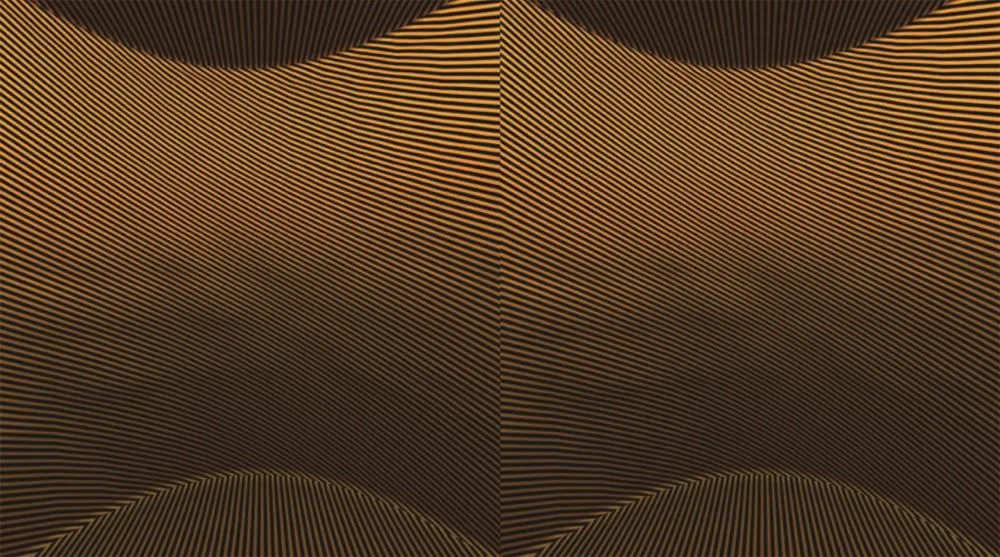
朗雪波 体积 Lang Xuebo, Volume
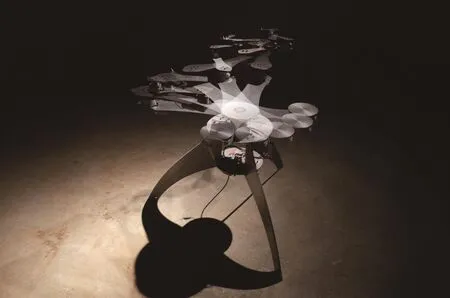
吴珏辉 响尾蛇 Wu Juehui, Rattlesnake
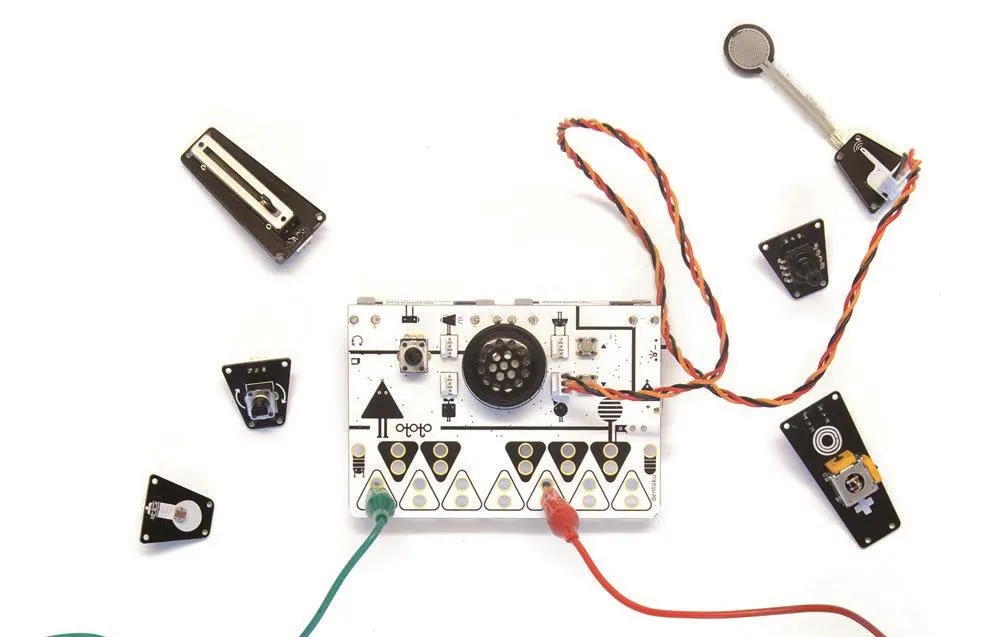
铃木有理 OTOTO Yuri Suzuki, OTOTO
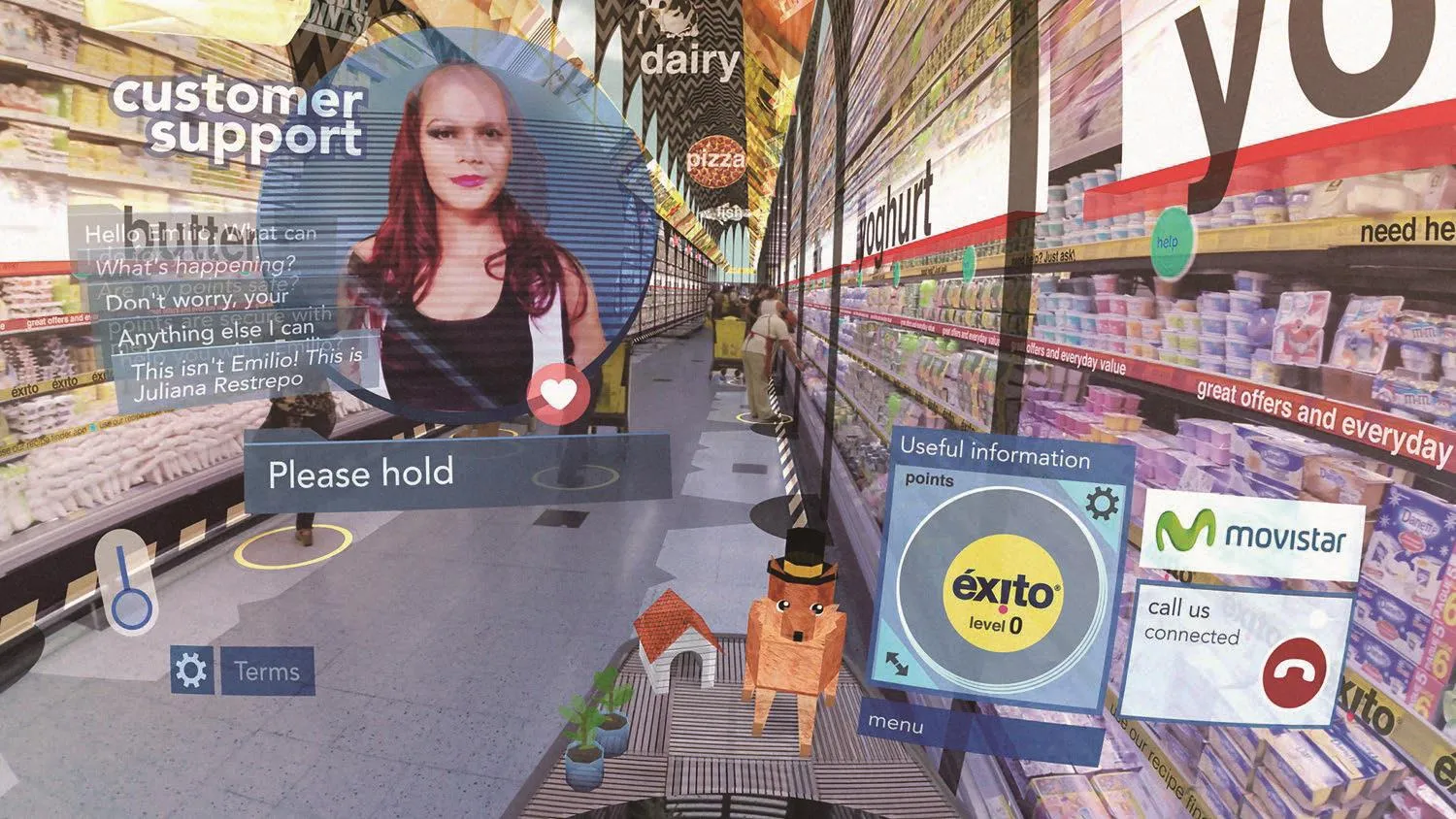
松田启一 超现实 Keiichi Matsuda, Hyper-Reality
混合现实。混合现实(MR)可认为是虚拟现实(VR)和增强现实(AR)的融合,它是结合真实与虚拟世界而形成的一种新的可视化环境,物理实体与数字对象共存并能实时地相互作用。
我们可在本板块中的艺术家松田启一的概念电影《超现实》中一探究竟。在短片中,物理现实与虚拟现实融为一体,整个城市被各式媒介所包围。科技既介入人们每一次的交互与体验,提供各种美妙的可能性,又控制着我们观察和理解世界的方式。
《体积》是中国艺术家朗雪波2016年的最新作品。此作品在虚拟情景中设置了一个全景式封闭空间,空间内全部被黑色与黄色的斜条纹有序地涂装,使观者沉浸于一个抽象的环境里,在环视和熟悉环境的过程中,从墙面、地面、上空将不断出现凸起物体向观者袭来,使平面的墙体条纹出现变形,然后又不断地消失从而恢复平静,呈现出焦灼不安的声音伴随。
人工智能。英国哲学家尼克•博斯特罗姆(Nick Bostrom)曾在其2003年发表的论文中认为,我们生活的宇宙时空可能是由某种高纬度生物制造的计算机所模拟而生成的,并提出人类的遥远后代可能会进化出或者创建出某种程序来适应计算机宇宙时空,以模拟过去发生的事件和重建远古祖先的生活方式。“机器智能是人类永远需要做的最后发明。”
音乐艺术家铃木有理的“OTOTO”是一套音乐发明套装,能让任何人轻松快速地DIY自己的电子乐器。打开OTOTO,可以创造各种乐器,从平底锅架子鼓到可触摸发声的折纸都能创造出来。套装的核心在于PCB合成器,如果将导电物质与合成器相连则可以触发不同的声响,通过将电子模块连接到四个不同的声音感应器来改变声响。
《响尾蛇》作为艺术家吴珏辉“错造物系列”的最新产物,是一个钢筋铁骨的动态装置(动态雕塑)。作品源于“π”这一数理概念的猜想,公转与自转正反叠加,衍生出无限不循环的形态变幻,正如圆周率的不可穷尽。瞬息万变的运动轨迹犹如宇宙天体的运转,亦如机械生命的游摆,从而生成一种无目的而存在的机械生命。
生物基因。生物基因的改造直接涉及“伦理”问题的讨论,在本板块可看到艺术家的有关“基因改造”的系列作品。
爱德华多•卡茨著名的《绿色荧光兔》是一件转基因艺术作品,卡茨运用分子生物技术将水母中的绿色荧光蛋白转入到兔子的DNA中,使兔子在紫外光下呈现出绿色荧光。本作品展现的理念不仅包括创造绿色荧光兔阿尔巴本身,还包括由此产生的公共对话及社会对这只兔子的接纳。
人造卫星子的影片《姻缘红线》,以一种轻松活泼的浪漫故事的形式去探讨科学与神话的关系,人造卫星子与日本农业生物资源研究所合作,给蚕蛹加入制造催产素(催生“爱”的荷尔蒙)的基因和红色荧光珊瑚的基因,让经基因改造的蚕吐出神话中的“姻缘红线”。从伽利略认定地球围绕太阳公转到达尔文的进化论,科学一直在挑战并消解神话世界。在不久的将来,科学是否会再造神话?
对于本次媒体艺术双年展,中央美术学院院长范迪安在前言中写道:“我们今天探讨技术伦理,不在于探讨技术已经达到何种发达程度,而是讨论人们能够在多大范围内接受技术、利用技术,既不拘囿于技术,又不干扰技术。”可以说,正是技术的发展引发了现代社会的发展,而与此同时问题也随之而来。德国哲学家海德格尔对技术发展导致的结果忧心忡忡,在他看来,现代技术的发展恰恰导致了人类的危险境况。在今天,这一点已经表现得极为明显——工业化技术的发展导致环境的破坏、人和自然的对立、地球的变暖等问题的出现。“媒体艺术的哲学命题远远高于艺术命题,因为后者实在是无法回应科学新创造的问题。”本次双年展的策展人王春辰教授如此表示:这场命名为“技术伦理”的双年展,不仅是一个充满“问题”的体验场,更是一个触发“问题”的实验室。
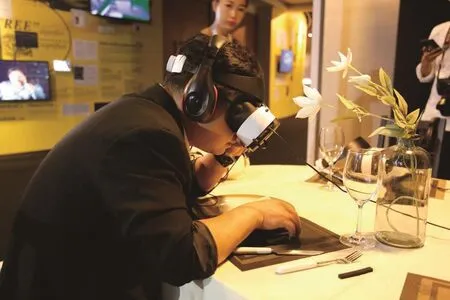
展览现场 Exhibition view
“Ethics of Technology” Thematic Exhibition: Composed of Five Sections.
The “Ethics of Technology” Thematic Exhibition, held at the Art Museum of China Millennium Monument, opened on the evening of September 25. It was divided into five sections, including Science, Big Data, Mixed Reality, Arti fi cial Intelligence and Bio-Genetics, covering almost all of the hottest technology topics.
Science. Driven by curiosity, human beings have embarked on a long journey in questing for the wonders of the universe.We use scienti fi c methodology to build and organize knowledge,and to explain and predict the universe with testable theories. In this section, artists skillfully combine rigorous scienti fi c theory with art. Their works are different in feature. Some are full of indescribable visual beauty; some are simple, straightforward,and thought-provoking. The artist Yunchul Kim is an artist living and working in Berlin. In his work Effulge, photonic crystals ascend and descend by the force of air pumped from the bottom,thereby constantly creating new figures and patterns inside the acrylic box. The Mouthpiece created by Brendan Warford is a device that allows people to wear over their mouth with phone displaying video footage of mouths crowd-sourced from the street. The Dai Yan Ren (speak for me) gives voice to anyone to ask fundamental questions, which are all too hard to answer.These questions are existential, ethical, and values. “All the questions which are beyond everyday emergency matters need to be asked, even we don’t know how to ask, what to ask, or too scared to ask.”
Jin Jun, one of the exhibition curators and vice dean of School of Design, Central Academy of Fine Arts indicated,“Science and art are originally two aspects pursuing the same goal. The combination of the two is also the direction of our pursuit and survival. We try to use technology to present art, and at the same time, we also try to show technical problems. ”
Big Data. There is no denying that the Internet has permeated every corner of our life. Whether you like it or not, we are in the era of big data that no individual can divorce from.
Jonathan Harris, an artist famous for his data and narrative,combines computer science, cartography, anthropology and photography. He explores in his works how humans can transform reality through different technologies. The Chinese artist Miao Ying’s video content comes from a popular video of a video website bilibili that has a “barrage” comment function.Joe Hamilton’s Stream explores the analogy of water and the internet. The structure and movement in the browser window have become a rigid framework that contains and shifts an array of found images and video of water. Waterfalls, torrents, rivers,creeks and streams of data fl ow down the screen.
Mixed Reality. Mixed Reality (MR) can be considered as the integration of Virtual Reality (VR) and Augmented Reality(AR). It is a new visual environment, which combines the real and the virtual worlds. Physical entities coexist with digital objects and they can interact with each other in real time.
We’ll find out the mixed reality in the artist Keiichi Matsuda’s concept film Hyper-Reality in this section. In this short film, physical and virtual realities have merged, and the city is saturated in media. Science and technology are not only involved in every interaction and experience, offering amazing possibilities, but also control the way we observe and understand the world.
Volume is the latest work of the Chinese artist Lang Xuebo,created in 2016. In the virtual scene there is a panoramic enclosed space. The viewers are immersed in an abstract space that painted with diagonal black and yellow stripes. Convex parts emerge from the wall, the fl oor and the ceiling successively and hit the viewers when they are looking around and sensing the environment. With an anxious sound, the strips on the walls distort, disappear and then restore calm.
Artificial Intelligence. The British philosopher Nick Bostrom pointed out in his paper published in 2003 that the cosmic space and time in which we live is possibly simulated and generated by a computer made by a high latitude creature,and suggested that the remote offspring of human may evolve or create some program to adapt to the computer cosmic space and time so as to simulate the past events and reconstruct our remote ancestor’s way of life. “The machine intelligence is the last invention people will always need to make.”
“OTOTO” of the music artist Yuri Suzuki is a musical invention kit, which allows anyone to create their own electronic musical instrument. With OTOTO you can unpack the kit and make anything from a drum kit of saucepans to origami that sings when touched. The core of the kit is the PCB synthesizer. The synthesizer can trigger out different sounds if some conductive material is connected to it. The sound can also be changed by connecting electronic modules to four outboard sensor inputs.
As the latest product of “Wrong Creation Series” of the artist Wu Juehui, Rattlesnake is a dynamic metal installation (a kinetic sculpture). It originates from the mathematical concept“π”. The superposition of revolution and rotation in the forward and reverse directions leads to in fi nite irrecurring morphological changes, just as the endless numerical value of π. The changing movement trajectory, like the movement of celestial bodies or the travel of mechanical life, generates an aimless mechanical life.
Bio-Genetics. Modification of biological genes is directly related to the discussion of “ethics”. In this section, you can see the series of works of “genetic modi fi cation”.
Eduardo Kac’s famous GFP Bunny is a transgenic artwork.Employing molecular biology, Kac combined jelly fi sh and rabbit DNA to produce a bunny that glows green under blue light. This work comprises the creation of a green fl uorescent rabbit (‘Alba’),the public dialogue generated by the project, and the social integration of the rabbit.
Sputniko’s fi lm Red String of Fate explores the relationship between science and mythology in a lively and romantic story. Sputniko has collaborated with scientists from NIAS in engineering silkworms genetically to spin this mythical ‘Red String of Fate’ by inserting genes that produce oxytocin, a socialbonding ‘love’ hormone, and the genes of a red-glowing coral into silkworm eggs (photograph of the actual oxytocin-induced red silk). Science has long challenged and demysti fi ed the world of mythologies—from Galileo’s belief that the earth revolved around the sun to Darwin’s theory of evolution and beyond—but in the near future, could science be recreating our mythologies?
About this Media Art Biennale, Fan Di’an, President of China Central Academy of Fine Arts, writes in the preface:“When we explore the ethics of technology today, we don’t explore what degree of development technology has reached,but to what extent people can accept technology and use technology, and to what extent they are not confined by and don’t interfere with technology.” It can be said that the development of technology has led to the development of modern society, and at the same time problems have followed.German philosopher Heidegger is worried about the result of technological development. In his view, the development of modern technology in turn has led to a dangerous situation for human beings. Today, this has been very obvious—the development of industrial technology has led to the destruction of the environment, the confrontation between man and nature,and the global warming. The curator of the biennale, Professor Wang Chunchen said, “The philosophical proposition of media art is much higher than its artistic proposition, because the latter is unable to respond to the problem of new creation of science.”The biennale entitled “Ethics of Technology” is not only an experience fi eld fi lled with “problems” but also a laboratory that may trigger “problems”.
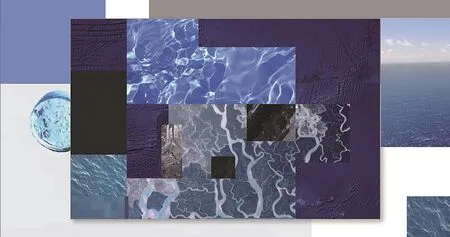
乔·汉密尔顿 流 Joe Hamilton, Stream
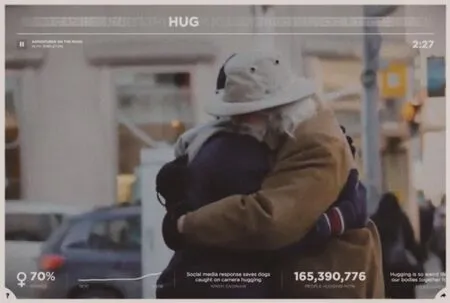
乔纳森·哈里斯 网络效应 Jonathan Harris, Network Effect
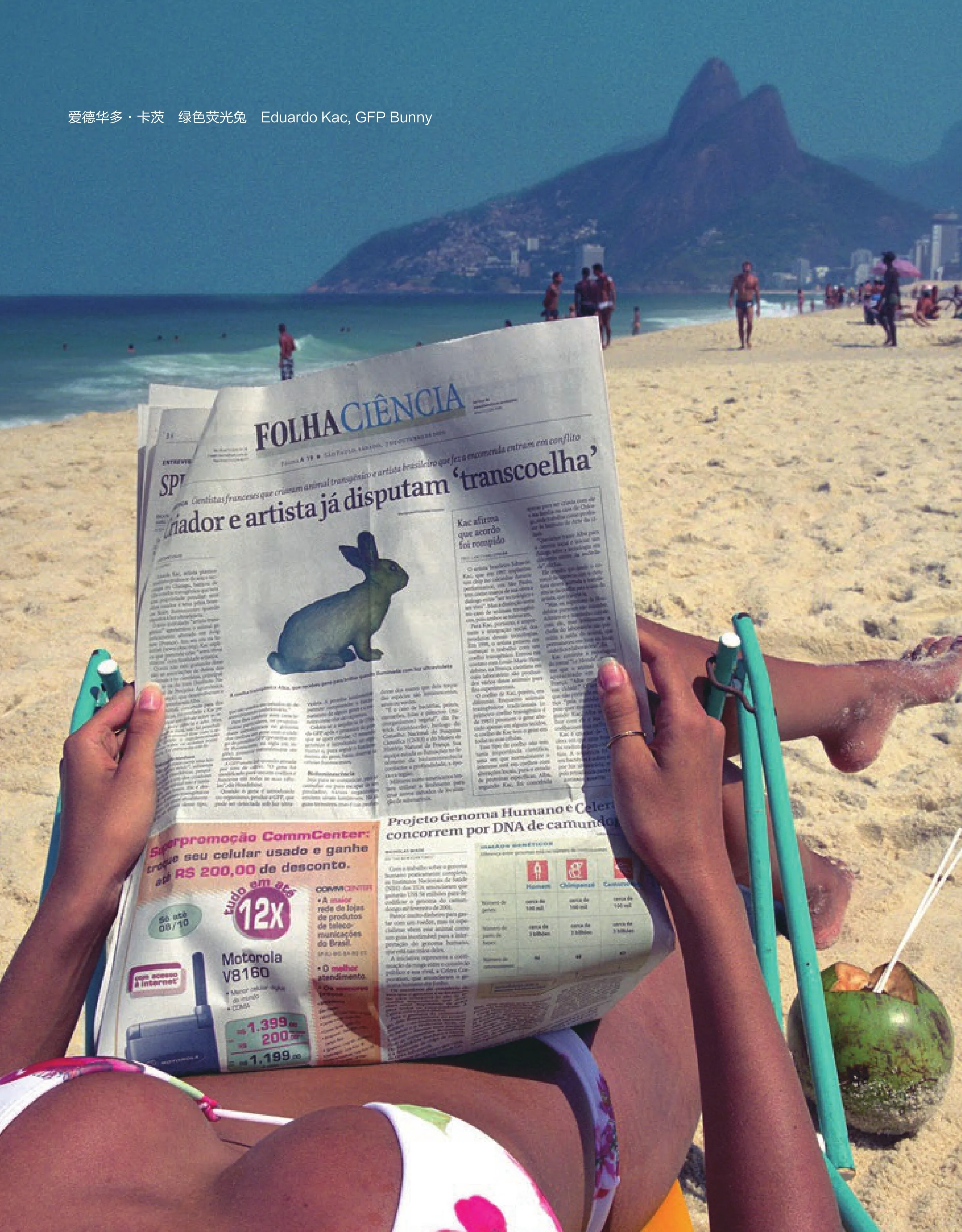
爱德华多·卡茨 绿色荧光兔 Eduardo Kac, GFP Bunny
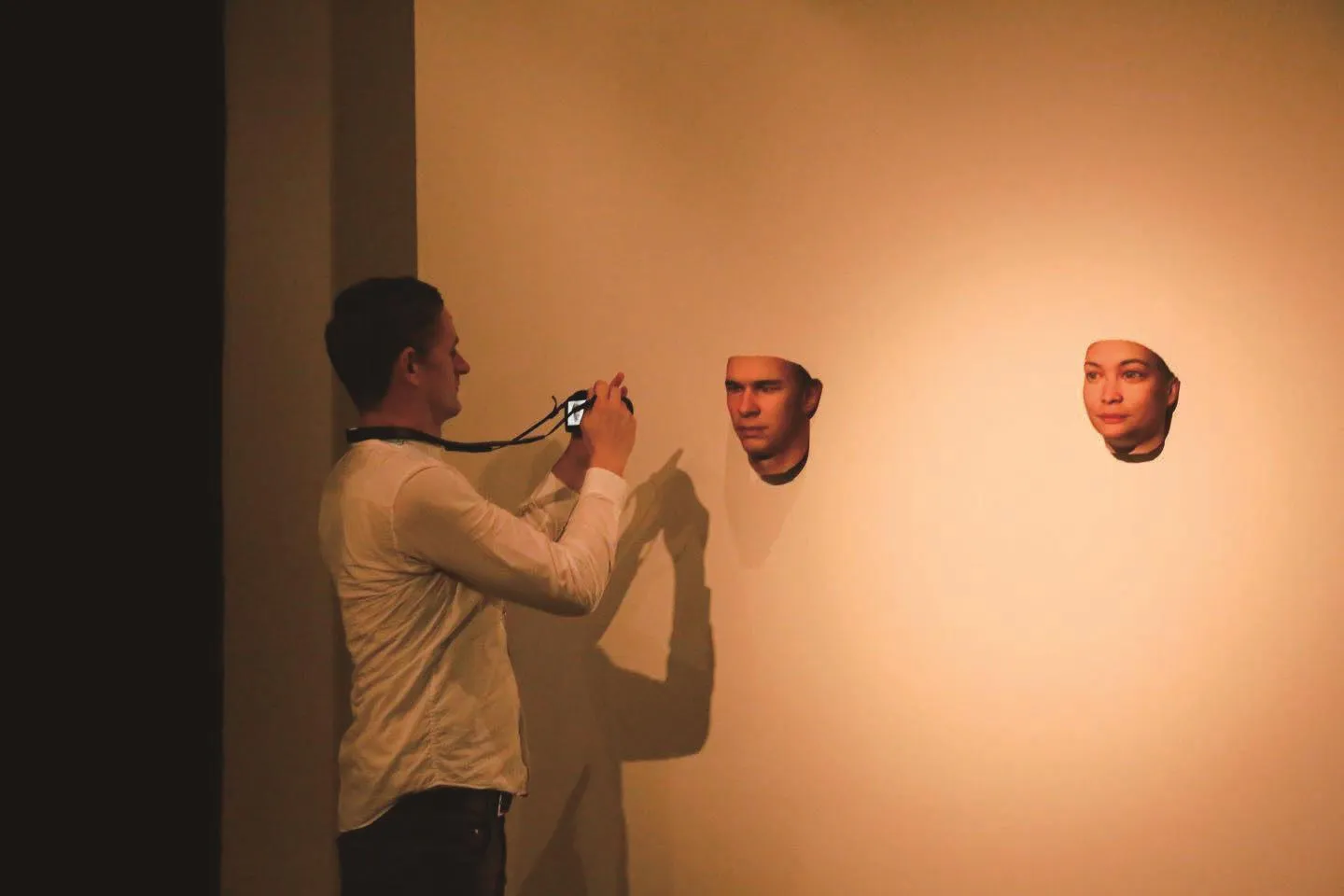
展览现场 Exhibition view
(本文附图由主办方提供)
林佳斌:中央美术学院艺讯网编辑部编辑
(Pictures are provided by the sponsor)
Lin Jiabin: editor at Editorial Department of China Central Academy of Fine Arts (Art Network)
Beijing Media Art Biennale: How Do Science and Technology Generate Art?
/Lin Jiabin
现代技术的迅猛发展使得“技术伦理”成为时下最热门的话题之一。历史学家埃尔斯佩思•惠特尼指出,没有一种古代学科分类像现在一样,将艺术全部置于技术之下。艺术作为文化、社会、技术等因素的混合产物,现今的人们已经难以根据其媒介形式来确定某件作品是否为某一种艺术形式。首届北京媒体艺术双年展选取“技术伦理”为主题。这次双年展不仅是一个充满“问题”的体验场,更是一个触发“问题”的实验室。
技术伦理;北京媒体艺术双年展;大数据;混合现实;人工智能;生物基因
The rapid development of modern technology makes“ethics of technology” one of the most popular topics at present. The historian Elspeth Whitney points out that no ancient classification of disciplines put art wholly under technology as we do now. Art is a mixture of cultural, social, and technical factors, but it is difficult for people today to determine whether a piece of work is a form of art according to its form of media. “Ethics of Technology” is chosen as the theme of the fi rst Beijing Media Art Biennale, and this biennale is not only an experience fi eld fi lled with “problems” but also a laboratory that may trigger “problems”.
Ethics of Technology; Beijing Media Art Biennale;Big Data; Mixed Reality; Arti fi cial Intelligence; Bio-Genetics

